#hes very interesting to analyze especially when comparing him to other characters intended to parallel him
Explore tagged Tumblr posts
Text
“people will say hes my comfort character and then post doflamingo” buddy i dont know what else to tell you but that theres nothing more comforting than knowing no matter how cringe you get, youll never reach “doflamingo begging for his ex to come back in front of a crowd at marineford” levels.
#one piece#donquixote doflamingo#not panels#ftr doffy is not a comfort character to me hes more ‘put in a jar and study him’ character#hes very interesting to analyze especially when comparing him to other characters intended to parallel him#(thats the reason i choose to interpret rosi saying he was born evil as just his own rationalization and not the actual canon bc thats borin#if i had to pick a one piece comfort character itd be perona. living her best life.
194 notes
·
View notes
Note
Oh ho ho so much to analyze. You weren't lying when you said the analyzers were going to be fed.
I like going chronologically through the chapter, so starting with Jack: The two of them have been close for a while now. With each moment they spend together, they grow closer, the bond strengthens. So it makes sense why they would be having this conversation now. Why it would be up on the roof with Jack that Wilbur decides to admit that his mindset is changing.
The parallel between Jack and Niki is insanely interesting to me. It's just that, a parallel. They're two separate people, and Jack cannot replace Niki. That's not what he's doing at all. Wilbur has so much history with Niki, and a lot of unresolved guilt over having to leave her behind. The narrative doesn't focus on the guilt itself very much, just his memories of Niki, and I think that makes a lot of sense. He's already got so many things going on in his life, especially after that fight with Tommy. He can't really afford to let himself feel guilty about Niki - but his thoughts wander to her all the same
Which leads me to Jack, who serves as a distraction (amongst other things). Not just a distraction from Niki, but a distraction from everything that's going on. Wilbur's constantly in a sort of mental fog. His thoughts are so loud, he's always so anxious, he's thinking too much at once and it overwhelms him. But not with Jack. Jack is the distraction - he clears away all of the anxiety, and lets Wilbur speak clearly and rationally. In the rest of the fic, stars!Wilbur resembles c!Wilbur from Pogtopia. He's paranoid, snappy, and his logical thinking gets twisted into something sinister. When he's around Jack, he starts to resemble President Wilbur. The man who spoke clearly and commanded respect. That's how he comes off to me
All because Jack isn't an asshole to him. There's a lot that goes into Jack's character and how he's earned Wilbur's trust. But ultimately it's a mutual respect where they both understand and appreciate each other. Something similar to what Wilbur had with Niki
I love Jack so much
(1/?) 🔥
aaa yes you get it! jack is in no way a replacement for niki, but he's a parallel to her! they're two separate people. wilbur has so much history with niki, and so much guilt like you said. but wilbur literally can't focus on his guilt right now because he's dealing with so much other stuff, so that's why we get more emphasis on the memories and missing her.
jack is a distraction exactly like you said. he can't solve wilbur's problems, but he can give him some space to breathe. if niki was around, she could help wilbur figure out where he's supposed to go and what he's supposed to do. jack isn't a politician, so he can't do that. but he serves an equally important role by distracting wilbur enough to let him get some of the fog out of his head. it's so interesting to me that you compare wilbur with jack to president c!wilbur, because while the similarities to pogtopia!wilbur and stars!wilbur were entirely intentional on my end, I didn't intend to shift stars!wilbur's behavior to l'manberg!wilbur's when he's with jack at all. it just sort of happened, and I actually really like that
yeah that's exactly it. it's mutual respect. jack was never an asshole to wilbur just for the sake of being an asshole. he's not a doormat and he'll get pissed at wilbur if wilbur is a bitch to him, but he treats him with respect. very similar to how he and niki worked.
ty i love jack too I find it so funny how he unintentionally became one of my fav characters in stars
10 notes
·
View notes
Text
Analyzing Marinette’s hairstyles
So, I’ve actually seen a bunch of different posts and takes of what Marinette’s hairstyles represent and symbolize especially in regard to the episode “Heart Hunter”, but I wanted to go through all the different styles of hair instead of solely focusing on the pigtails/hair down of that particular episode.
With that being said, in no particular order, here we go:
The Bun

This hairstyle is almost exclusively seen in the episode “Animaestro”. However if you’re paying close attention, you will see Marinette wearing this hairstyle, in the old class picture, featured in “Reflekta”. I find the fact that the show made this connection between these two (scenes? examples?) incredibly interesting and very telling. Putting the class picture aside for a moment, one must analyze Marinette’s behavior in the episode “Animaestro”. To be sure, it isn’t great. For the most part, Marinette acts foolishly and immaturely and her actions in this episode, indirectly lead to the akumatization. Marinette, in her jealous state, goes so far as to join up with Chloe (a person she despises), and attempt childish pranks on Kagami. In short, I think that the bun hairstyle symbolizes a sort of immaturity for Marinette. The fact that she wore this hairstyle when she was younger only goes to prove my point. Marinette is not a perfect character, but her actions in “Animaestro” are arguably some of her worst, and naturally when she has hit a low in her maturity level, she reverts back to a hairstyle of her youth.
The Braid
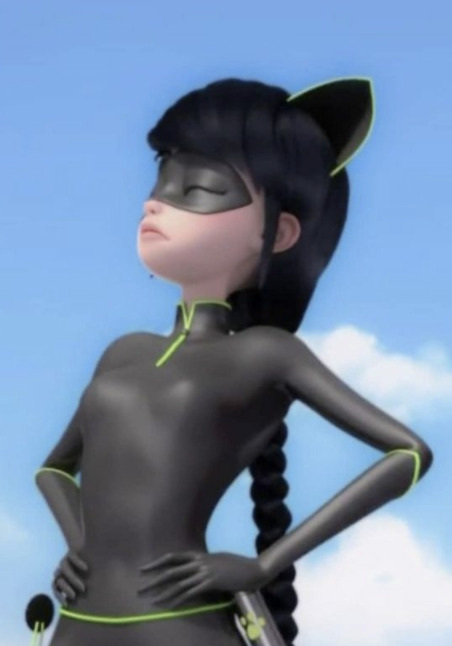
The braid can be easily shoved aside as not holding any symbolism, as just a way the design team chose to incorporate the tail in her costume. However, there were a number of ways the tail could have been incorporated into the Ladynoir costume, and as such the braid must be analyzed. Now, a braid can be considered an almost restricting thing, it carefully tucks back locks of hair and traps them better than an ordinary ponytail can. However, the Ladynoir braid almost has a ‘fun’ twist to it (pun not intended but appreciated). It is long (like really long), and we even see her flick it playfully over her shoulder. I think that the braid is supposed to represent that dualism between responsibility and fun that the job of superhero can have. I have heard a lot of people criticize “Reflekdoll” for its lack of parallels. In other words, Chat Noir learns something and better appreciates Ladybug, but the reverse isn’t true, and I would say that in many ways this is true, Ladybug is not privy to the lesson that Chat Noir is. However, I would argue that she did learn something. Ladybug learned that it’s okay for her to have fun and to joke around. Towards the beginning of the episode we see Ladybug chastising Chat Noir for his joking around, however by the end we see Ladybug embrace this approach and even make some jokes herself. The braid shows Marinette acceptance of balance, of the combination of enjoyment and responsibility within her life.
The Space Buns
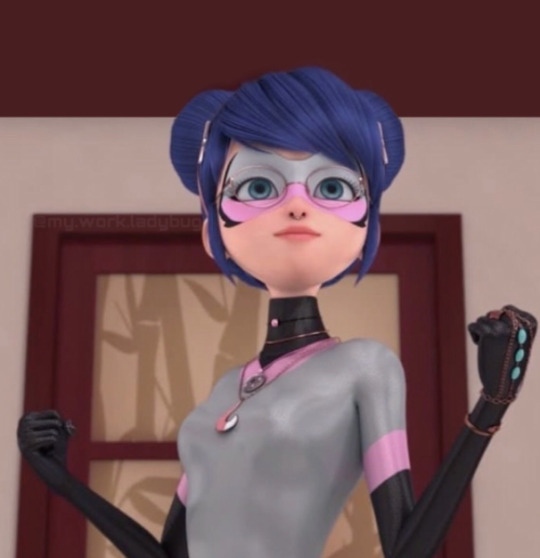
This design as well can be attributed to the design team finding a way to show mouse ears, but I’m still going to try to analyze this. I have two different ways to possibly explain this hairstyle. The first being to draw parallels to the bun hairstyle as this is essentially the same thing but two instead of one. The correspondence between the two hairstyles could be seen through Marinette’s feigned naivety in front of Chat Noir. She “accidentally” reveals herself as Marinette and pretends to be less informed than she really is. The other way to translate this hairstyle is as a security blanket so to speak. I haven’t gotten into the metaphorical interpretation of Marinette’s pigtails yet, but I will briefly explain a part of it now (and go into depth a little later). The pigtails serve as a sense of security for Marinette, as a source of status quo. The space buns are that, but elevated. In the episode this hairstyle is featured, “Kwamibuster” (I don’t think I mentioned this before), Marinette is desperate to keep her identity a secret from Chat Noir and develops a convoluted plan (including Multi-mouse) to accomplish this. She wants the security of her identity and wants to use her comfort style at this moment. However, Marinette is trying to distance herself from Ladybug and as such she uses a slight variation of her pigtails in her alternate hero form.
The Ponytail
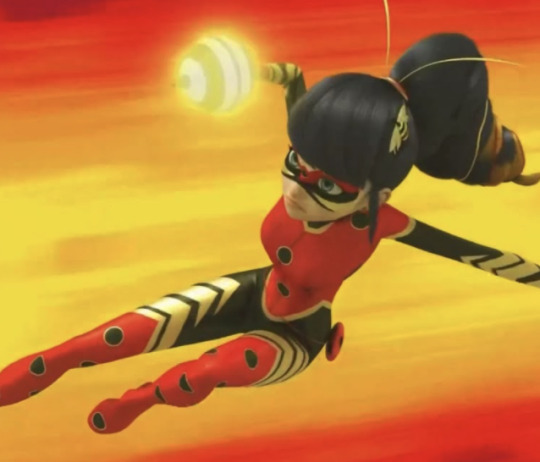
I’m gonna be honest and say that I can’t fully analyze this hairstyle as we have not yet seen the episode where this hairstyle makes its second appearance. So I’m just focusing here on the ponytail from “Optigami”. I might make another analysis on the ponytail after “Sentibubbler” comes out but it might make more sense to wait until after the whole season comes out, in case there are new examples of ponytails (or other hairstyles for that matter). I don’t want to say anything about Pegabug’s ponytail, because as I’m sure you know, Miraculous trailers can be very misleading. Anyways, after that ramble, I now focus on Ladybee’s ponytail. To be frank “Optigami” was a bit of a doozy. I watched that episode with a sense of dread that did not lighten by the end of the episode. This isn’t a bad thing, but it was intense for a typical episode of Miraculous, a show where my usual reaction is a mix of “oh this is cute” and cringe (to be fair I cringe easily). But what I like so much about season 4 is that we get more than that (I won’t go into this now because I’m straying from the topic too much). Ladybee comes at a time of great stress for Marinette, she gets stuck in an elevator with someone and is thus unable to transform (let alone the fact that that “someone” is Adrien), she is without the help of Chat Noir and most of the other heroes, and (unbeknownst to her for a majority of the episode) her friend has been replaced with a sentimonster. Yet, despite all of this, Marinette remains cool, calm, and collected. She, unlike Alya, does not fall apart and despair when Senti-Nino is revealed, she knows she has to get the job done. A ponytail gives an image of “getting the job done” of focus. Although the situation is dire and dangerous, Marinette displays her competence in crisis and the ponytail magnifies that trait. I have a feeling that the same will be true for Pegabug, but only time (and the episode coming out) will tell.
Hair Down

In the two episodes that we have seen Marinette wearing her hair down, they were both in connection with Adrien and her relationship with her. I want to separate the two examples because though they both wind up achieving similar goals in regard to their symbolism, they do it in different ways. Focusing first on “Chat Blanc” Marinette wears her hair down in part to distinguish to the audience the difference between the two timelines. Though the surface level explanation of her hair would be sufficient explanation, this choice of hairstyle also has a deeper interpretation. This being as a metaphor for Marinette’s vulnerability. She is allowing her feelings to be known to Adrien, she is allowing herself to be open and honest about her emotions and with that freedom she lets her hair free as well. It is also significant that she is free from her secret identity (albeit unknowingly) and as she allows Adrien to see the full spectrum of her personality, she frees her hair from its restraint. In “Heart Hunter” too, this hairstyle signifies vulnerability and freedom. In this episode we see Marinette having fun with Adrien and Kagami, without the worry of how she is being perceived by Adrien, without the stress about her feelings for him. It is of great significance that when she lets her guard down, when she “lets her hair down” (both literally and metaphorically), Adrien comments on her beauty. We already know, as viewers, that Adrien has fallen in love with Marinette’s personality as Ladybug. But as Marinette, Adrien has not been privy to her full personality. He has only been given glimpses, as in this episode, to the full extent of her persona. Marinette is seen later on in the episode to revert back to her old hairstyle once she is no longer comfortable, when she feels inadequate compared to Kagami. She puts back on her guise when she feels she needs the security. Which leads us to that source of security.
Pigtails

I feel a bit bad as I have simplified this hairstyle in earlier paragraphs to a symbol for security. While this definition is a correct one, this hairstyle has more than one explanation. As Marinette’s primary hairstyle, in both her every day and hero outfits, we see this hairstyle A LOT. Because of this, there is an array of interpretation as to what this hairstyle could mean. Starting with the aforementioned, this hairstyle works as a form of security for Marinette. The style required her to hold her hair back, to keep it in check, away from possible disasters and viewers (wind can tangle hair very easily). The pigtails are the antithesis of letting her hair down, a common symbol for freedom and relaxation. The pigtails therefore show that she is on her guard and is protecting herself. The pigtails also represent her quality of being a do-er. She likes to do things, she is an active person, she doesn’t stand aside or wait for things to happen, she works to make them happen. As a do-er she needs focus, she needs a restraint for her hair that could get in her line of sight, and the pigtails do that well. As Ladybug, the same is true. She is focused and determined to accomplish her goals, to succeed in her battles and she needs to tie her hair back to best accomplish this. There is importance in the fact that she chooses to focus herself with pigtails rather than the equally practical ponytail. This can be attributed to the child-like quality that pigtails have. Marinette, simply put, is still a child. Though as a whole she is particularly mature for her age, at times she can show a bit of immaturity. It is interesting to note that as the seasons progress, the more we see her with other hairstyles. As she matures she wears the pigtails less. The pigtails are also a girly hairstyle and show how Marinette is a girly-girl in a plain and easy way. Additionally, the pigtails give her the approachable, girl-next-door look. In simply looking at Marinette one gets the image of her sweetness and good nature. In visual media, it is important to make a connection between personality and visage. In cartoons especially, a character’s design should fit with how they interact with their world, and the pigtails are an immediate signifier as to Marinette’s character. This about sums up my analysis of her pigtails. I know that there are more ways to interpret them, and feel free to comment if you think of any other interpretations!
#mlb#mlb spoilers#spoilers#miraculous lb#miraculous ladybug#miraculous tales of ladybug and chat noir#marinette#marinette dupain cheng#ladynoir#multimouse#ladybee
88 notes
·
View notes
Text
Feathers of Truth and Judgement
Ma’at and the Weighing of the Heart: Revisiting the Death of Jin Bubaigawara
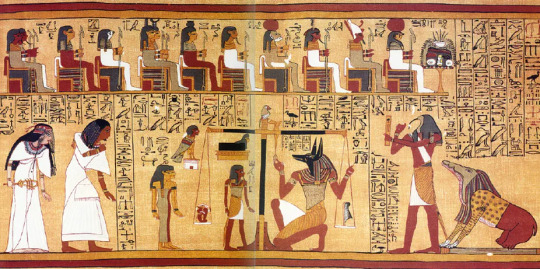
Before I begin, this may not make any sense if you are not familiar with some of what I’ve written about. This is an add on to my post about the interesting similarities between Hawks’ character and the Egyptian God Horus.
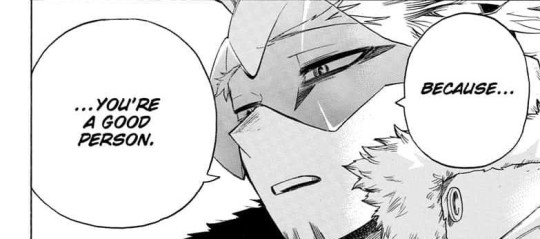
Recap: Tokoyami, Hawks and Endeavor
To recap what I’ve already written previously, there are most definitely Greek/Roman mythological influences in BNHA but there are also Egyptian ones as well most explicitly through Tokoyami Fumikage who basically looks like how Egyptian dieties were portrayed: the head of an animal and the body of a human. Additionally, he has a move named after an Egyptian symbol, the Ankh and his quirk, Dark Shadow is basically a version of the Egyptian concept of the shadow, called shut/swt.
And so I began looking at where else there may be some interesting similarities between BNHA and Egyptian mythology, and eventually started making some connections between Hawks and Horus, and Endeavor and Ra, the Sun God that fit the narrative and symbolism of the two characters. Whether they are mere coincidences or unintentional, I still think that it is interesting to look at and consider. So here we are.
The Egyptian Underworld

The image above is from the Book of the Dead of Ani. Osiris is depicted sitting with Isis and Nephthys behind him.
In Egyptian mythology, Horus is the son of Osiris and Isis. One of the most famous stories tells of how Osiris’ brother Set takes his life, cuts his body in to several pieces and disperses them across Egypt. A spirit can only travel in to the underworld if they are properly embalmed and buried so Horus and Isis travel around and search for the parts of Osiris’ body. (Depending on the source you are looking at, some say that Isis traveled around with her sister Nephthys, and Horus was born after she resurrects Osiris).
Osiris is resurrected and is able to travel to the underworld where he becomes the Egyptian Lord of the Underworld, and the Judge of the Dead.
Why am I bringing up Osiris? Well his son, Horus is important in relating back to Hawks and Endeavor, but he also leads us to another important deity who I will introduce later. Back when I was gathering information to work with, I noticed that there was some interesting bits about the Afterlife and Judgement process I wanted to add in but to keep it simple, I cut that part out. However, I thought that this was too interesting to not post about.
The Egyptian Afterlife and Judgement
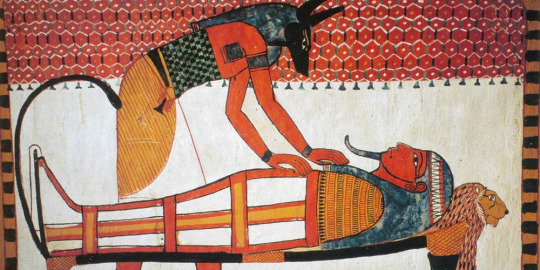
In order to illustrate and explain what the ancient Egyptians believed happened after an individual passed, I included a large excerpt below from the World History Encyclopedia:
In the Egyptian Book of the Dead it is recorded that, after death, the soul would be met by the god Anubis who would lead it from its final resting place to the Hall of Truth.
When it came one’s turn, Anubis would lead the soul to stand before Osiris and the scribe of the gods, Thoth in front of the golden scales. The goddess Ma’at, personification of harmony and balance, would also be present and surrounded by the Forty-Two Judges who would consult with these gods on one’s eternal fate.
The soul would then recite the Negative Confessions in which one needed to be able to claim, honestly, that one had not committed certain sins. The negative declarations, always beginning with “I have not...” or “I did not...”, following the opening prayer went to assure Osiris of the soul’s purity. Each sin listed was thought to have disrupted one’s harmony and balance while one lived and separated the person from their purpose on earth as ordained by the gods.
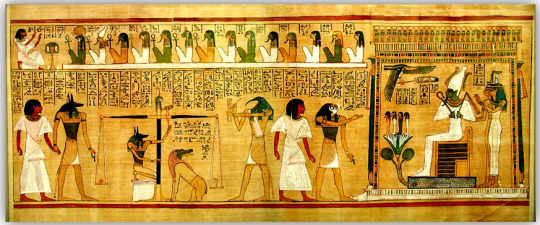
Anubis or Qebhet, his daughter weighs a human’s soul against the weight of the feather of Ma’at while Osiris watches on, Isis and Nephthys behind him.
The ‘heart’ of the soul was handed over to Osiris who placed it on a great golden scale balanced against the white feather of Ma’at, the feather of truth on the other side. If the soul’s heart was lighter than the feather then the gods conferred with the Forty-Two Judges and, if they agreed that the soul was justified the person could pass on toward the Field of Reeds, or paradise.
If the heart proved heavier, it was thrown to the floor of the Hall of Truth where it was devoured by Amenti/Amut. Once the person’s heart is devoured, the individual soul ceased to exist (The ancient Egyptians had no concept that is equivalent to the Judeo-Christian hell).
I’m sure you’ve identified one of the key highlights from the excerpt above that connects directly to Hawks: Ma’at’s feather. Let’s take a closer look at the deity.
The Goddess Ma’at, the Feather of Truth and Judgment
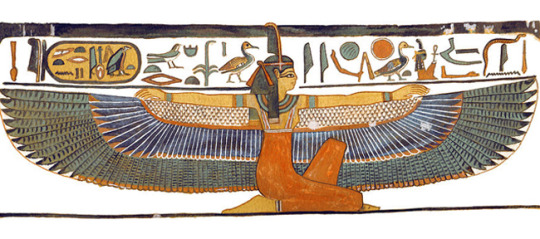
In ancient Egyptian mythology, Ma’at was the goddess of truth, justice, balance and morality. She is often depicted as a woman, with a feather on her head and/or with wings (as depicted above). She was the daughter of the sun god Ra, and the wife of Thoth, the god of wisdom and the moon.
The feather she wears on her head symbolizes her being and presence. It was a representation of balance and order, and it eventually became a hieroglyph for “truth.”
Truth, truth, truth, what does it have to do with Hawks? Well, Hawks is a man who yearns for the truth. He seeks information out, collects it, and analyzes it. When he was first introduced he was shrouded in mystery, people wondered, was he someone to be trusted?

While he could be very blunt with the truth, he was also very deceptive and good at lying. Truth and knowledge is very intertwined with his character design as we see in his name.

Hawks’ true name, gets revealed to us through Dabi: Takami Keigo. According to the BNHA fandom website, Hawks’ surname translates as:
“hawk” (taka 鷹) + “see, visible, idea” (mi 見 )
While his first name translates as:
“disclose, open, say” (kei 啓) + “enlightenment, understanding” (go 悟).
What does Hawks do with all the information and “truths” he gathers? Well, what do we do when we hear or discover the truth?
We make a judgement.
In the court of law, truths and evidences are used to pass judgement. In ancient Egypt, Ma’at was associated with the law and justice.
The ‘Spirit of Ma’at’ was embodied by the chief judge in charge of the Egyptian law courts. He had a dual role, serving as both a priest and working directly in the law courts and justice system. They wore the feather of Ma’at and all other court officials wore small golden images of the goddess as a sign of their judicial authority, also as a symbol that their judgement would be balanced and fair.
Priests drew the Feather of Ma’at on their tongues with green dye, so that the words they spoke were the truth. They would rule on the earthly punishment according to the nature of the law that had been broken.
Punishments included imposing fines, corporal punishment and in extreme cases capital punishment. It was considered a crime against Ma’at if a person engaged in jealousy, dishonesty, gluttony, laziness, injustice, and ungratefulness (ancient origins).
Hawks’ Fierce Wings quirk gives him the ability to turn his feathers in to weapons as we see below which is quite ironic or absurd to think about.

How can a feather condemn someone to death? Well as we saw earlier, in ancient Egypt, one’s fate was determined by the sins they committed in the life they led, and ultimately the weight of their soul compared to that of the Feather of Ma’at.
We are presented with Jin’s backstory that Hawks was most likely able to dig up through his sources which is how he got to his conclusion.
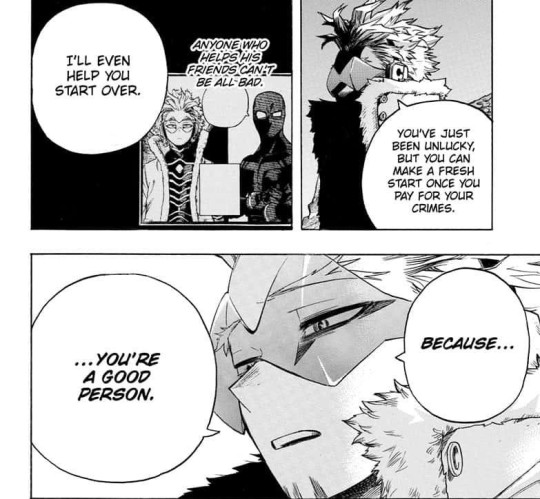
Similar to the process that takes place in the Hall of Truth, Jin’s past and life is reviewed, gone through, and he see how he came to be the person he was. Hawks calls him unlucky. He believes that Jin is a good person, and can be helped.
The problem is, is that heroes are no supposed to act as the judge, jury or executioner. The main role of heroes is to save, and subdue those who are dangerous, passing them on to the police and courts of law: as Hawks was originally intending to do.

But as Jin continues to resist, Hawks changes his intentions.

Their struggle concludes with the death of Jin Bubaigawara.
The Heroes are not Gods

The ancient Egyptians looked to Ma’at to maintain the balance and harmony between good and evil. She represented the truth and morality, and under her guidance those behind the law passed judgement.
However Hawks is not Ma’at. He is not a god. Instead of acting as a servant of the law, Hawks takes it upon himself to embody and become the law. But on the basis of what exactly? It does not matter because he passes judgement himself. He takes his feather and executes Jin based on what he believes is the truth and justice. We are reminded of this objectiveness through the subtitle of Volume 27: One’s Justice.
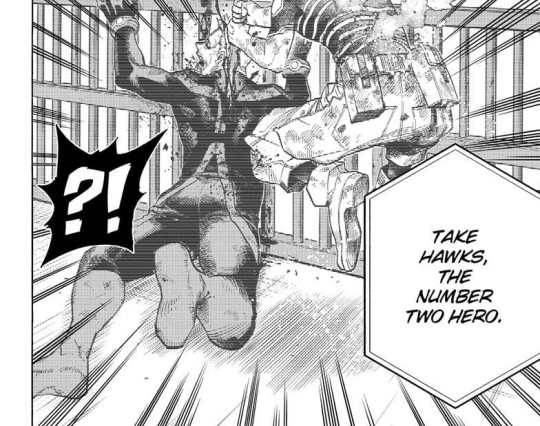
For the longest time, heroes basically were perceived as living gods. Even worshipped, to an extent. Quirks set heroes apart from civilians, placing them on top of the pyramid of power. People lived in a hero saturated society, similar as to how the ancient Egyptians lived with their deities being a part of a great majority of their day to day existences. Despite all the interesting connections and parallels that I can write about, especially with Endeavor and Hawks, it does not change the truth that they are still human: as human as the quirkless. Perhaps their greatest fault was that they acted and lived like gods.
As always, thank you for putting in time to read through this post! I appreciate it. Manga panels throughout this post are from Chapters 264, 265, and 291
#hawks#takami keigo#twice#jin bubaigawara#bnha analysis#mha analysis#bnha meta#mha meta#mythological influences#bnha#mha#bnha spoilers#mha spoilers#luna writes#my post
48 notes
·
View notes
Text
Winterfell’s Daughter. On Sansa Stark (part 1)

As a book reader and a fan of Sansa Stark, Game of Thrones is often an intensely frustrating experience because many of the adaptational choices do her character a real disservice, not just once or twice but consistently. Thus it is very tempting to compare and contrast the books with the show. However, since I intend for this to be a character analysis based on the show, I’ll try to refer to the books sparingly and rather focus on analyzing what is on the screen instead of ranting about what was excluded.
Sansa is very much an internal character – she lives in her head, something that becomes even more pronounced when she becomes as hostage because though she is actually very observant, she cannot speak her thoughts openly. She is also a very passive character for a large part of the story because she is a prisoner. She is at the mercy of other people and she has very little agency herself. Thus, her character is difficult to transfer to the screen where she very much is viewed from the outside. The audience isn’t in her head and that can make her more difficult to read. It is a character that requires an actor that is strong with non-verbal cues and fortunately, young Sophie Turner has developed into just such an actress.
DIFFERENT FROM HER FAMILY
Sansa is very much a child that conforms to the expections that accrues to her gender and her social status. She is a conformist and obedient child and yet she is also a bit of an “outsider” within her own family. This “outsider” status is visually articulated from the very beginning of the story. When we first meet the Starks, Ned, Catelyn and all they boys are outside in the castle courtyard. On the other hand, the audience meet Sansa and Arya in an indoor space, engaged in the art of embroidering, which is coded as exclusively feminine. However, Arya quickly leaves the confines of the sewing circle and runs outside to engage in archery with her brothers. Sansa’s difference from her family is further emphasized when the Starks line up to meet the King. All of the Starks are clad in fur-decorated cloaks. However, unlike the cloaks of her parents and her siblings, Sansa’s cloak is of of a light blue colour that matches her dress. Visually, she sticks out like a sore thumb.
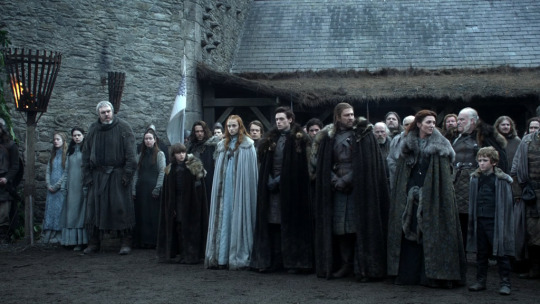
From the very start, Sansa is singled out as different from the rest of the Stark through purely visual means. It isn’t something that the show (or even the books) delves very deep into but part of Sansa’s isolation within her own family is tied to her gender. Like all other highborn children, boys and girls are educated differently in the Stark family. The distinction between inside and outside spaces encapsulates the gender divide in the very first episode.
The lives of highborn girls are proscribed by a number of restrictive social conventions – almost all highborn women in Westeros are forced to engage in compulsory femininity. This is not a problem for Sansa since her interests and talents conform to the social restrictions placed upon her gender. Arya, on the other hand, doesn’t conform. She rebels and engages in activities normally reserved for boys. In that sense, Arya shares something with her brothers that Sansa doesn’t. In fact, Sansa’s feminine world is very much cut off from the sphere her brothers inhabit. Thus, Sansa conforming to gender norms also marks her as a bit of an outsider in a family of four boys and one tomboy. Therefore, it shouldn’t be that surprising that Sansa is eager to leave Winterfell – even if it is her safe and loving home. She desperately wants to find a place where she “fits” in a way she doesn’t “fit” in at Winterfell.
NAIVITY AND ROMANTICISM
Her conversation with her mother before the banquet is the first real introduction to Sansa as a character. This conversation tells us that she is dazzled by the royal glamour; she wants to make a good impression on Joffrey. She gushes about Joffrey’s looks, asks about when they’ll be married, etc. She’s in a hurry to leave WF and rush into adult life. She’s got stars in her eyes.

It is clear that Catelyn doesn’t share Sansa’s enthusiasm for getting married quickly. She tries to point out that getting married would mean Sansa leaving her home, to which Sansa replies that Cat had to leave her home to come North. Catelyn doesn’t have a rebuttal to this comment – because it is true. Sansa (as well as Arya) would always have to leave home when they marry.
Sansa’s naïve enthusiasm for getting married, leaving home and becoming queen is in a sense framed as something silly: she acts like a starry-eyed girl who thinks she’s starring in the Westerosi equivalent to a Disney story. However, I do think we ought to look at the way Sansa buys into this whole “fairytale” isn’t about her being silly, vain and frivolous. A big part of her season 1 arc is about how this ideology of courtly romance that Sansa espouses is a trap, a pretty lie that serves to make lull girls like Sansa into passively accepting their fates as a genteel form of human livestock. The sad fact is that Sansa has absolutely no influence on her betrothal. Robert summarily decides upon it in a sentimental moment where he mourns the losses of the past. Even Ned passively accepts Robert’s fiat – none of the adults seems to consider whether this is a good match, both in terms of personality and politics. Hell, Ned has no idea what kind of boy Joffrey is and whether he’ll make a good husband for Sansa. He doesn’t even seem to question it until confronted by Arya in ep03!
It is a shame that the show completely erases all references to the songs and romances of Westerosi culture; elements, that along with the ideology of knighthood, constitutes the core of the culture of Courtly Love and Chivalric Romance. It is a world where princes and kings are noble and brave, where queens and ladies are beautiful and gracious and where knights are honourably defend the weak and helpless. Through popular songs and literature (like the stories about Florian and Jonquil, Aemon the Dragonknight and Queen Naerys, etc.), Sansa has been conditioned to romanticize and idolize knights, etc. unquestioningly. By removing this aspect of Sansa’s character almost entirely, the show has effectively removed the context for Sansa’s ideals, which informs her worldview and her behavior. It is indirectly represented but it is easy to overlook if you haven’t read the books and if you aren’t conversant with the Medieval culture of Courtly Love that serves as GRRM’s inspiration for this part of the cultural fabric of Westeros.
Ironically, Sansa isn’t the only family member who is eager to leave Winterfell. The scene between Sansa and Catelyn is followed by a scene between Jon and Benjen, where Jon hotly argues that he is ready to join the Night’s Watch. “Father will let you if you ask him”. Benjen advises patience – arguing that Jon doesn’t know what he’s giving up. This gif set perfectly illustrates the parallels between Jon and Sansa. Jon is an outsider in a very different way than Sansa – as a highborn bastard, he is set apart from his trueborn siblings (especially by Catelyn) but he is also privileged because he is the bastard of a High Lord. However, he is just as idealistic as Sansa when it comes to his destination. The difference is that Jon’s disillusionment is quick and permanent whereas Sansa’s disillusionment is slower process, partly because various people are actively trying to keep her trapped in the illusion, which is something that I’ll explore later on.
The interesting part is, that both Sansa and Jon look to establish their worth outside of Winterfell. Sansa by becoming queen and Jon by proving himself at the Wall. I’d argue that this is partly caused by them not “fitting” easily into the family. Jon because of his birth and Sansa because her interests and talents isolates her from her siblings. Arya occupies an outsider status as well, but in a different manner. Life is sometimes difficult for her because she doesn’t conform to gender norms. However, she shares interests and talents with her brothers and Ned secretly indulges her. So despite Arya’s struggles with the performance of compulsory femininity, she isn’t isolated within the family because her siblings value her interests in a way that the Starklings don’t do with Sansa’s embroidery and songs. It isn’t stated directly but the audience is shown Arya and her brothers bonding over weapons practice straight after Arya rejects the sewing circle that Sansa is part of. Arya doesn’t care for embroidery and it is such an exclusively feminine activity that I doubt that the boys holds it in any kind of value either. [This makes Jon’s compliment of her homemade dress in season 6 extra meaningful!] I think that it is notable that Arya doesn’t want to leave her home. She’s happy at Winterfell, despite the gendered restrictions that are laid upon her.
GRRM created Sansa as a source of conflict within the Stark family. The Starklings simply got on too well. However, his choice to make the contentious Stark a traditionally feminine girl in a family of boys and one feisty tomboy has had the unfortunate side-effect of tapping into a of more or less subconscious misogynistic discourse when it comes to the audience’s reception of Sansa’s character. Like all the other characters in this story, Sansa has her flaws. She makes mistakes and she pays dearly for them (though she also pays for the mistakes of others). However, a LOT of the criticism that is levelled at her character draws on deep-seated patterns of misogynist thought. For a large number of readers, Sansa’s greatest sin is being a feminine girl and those of her traits that are coded as conventionally feminine are often judged negatively, fx her romanticism, her love of pretty things, etc.
To be continued...
338 notes
·
View notes